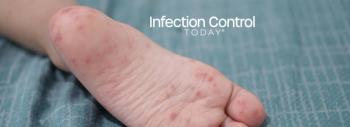
Study Demonstrates Benefits of Universal Surveillance for MRSA and Reveals Need for Repeated Testing
A new study released at the American Society for Microbiology's 46th annual Interscience Conference on Antimicrobial Agents and Chemotherapy (ICAAC) shows that implementing universal surveillance, which introduces the testing of all admitted patients, is far more effective than just passive or targeted active surveillance when monitoring for methicillin-resistant Staphylococcus aureus (MRSA).
Released by Evanston Northwestern Healthcare, the study finds that the majority of patients admitted harboring MRSA are not typically identified via passive or targeted active surveillance. Passive surveillance detects patients with clinical cultures only and is the method most commonly used for identifying MRSA in hospital patients in the U.S. Targeted active surveillance is used when particular areas of the hospital are labeled as high risk and all patients in those wards are screened.
A second study conducted by the investigators characterized the decay pattern of MRSA colonization in a real-life population of retested patients in a universal surveillance and decolonization program. Results showed that re-colonization can occur, demonstrating the need for re-screening to detect re-colonization of patients upon each admission to the hospital.
Both of these studies show that active MRSA surveillance at patient admittance is critical to reduce the ongoing spread of MRSA within U.S. hospitals, said Dr. Lance Peterson, director of microbiology and infectious disease research and one of the authors of the study. Universal surveillance may not be immediately feasible for many organizations, but in the interim targeted surveillance is an acceptable alternative that can identify MRSA carriers that could spread the bacteria, particularly in hospitals with a high percentage of total bed capacity being ICU beds.
Past research has shown that of patients harboring MRSA at admission, up to one in five develops an infection.(1) For patients who acquire MRSA while in the hospital, up to one-quarter develop a potentially lethal infection.(2)Â
In the U.S. alone MRSA accounts for nearly 60 percent of the Staphylococcus aureus infections in intensive care units.(3) This compares to less than 10 percent in Canada and less than two percent in some Scandinavian countries.(4) Additional data from Evanston Northwestern Healthcare highlights that universal admission surveillance is cost-effective and can have a significant impact on reducing nosocomial infections of the blood a significant cause of prolonged illness and death.
Both studies were conducted by Evanston Northwestern Healthcare with the purpose of analyzing their infection control intervention of universal MRSA surveillance and decolonization of MRSA carriers. The first study of this intervention compared the three competing strategies for detecting inpatient carriers of MRSA. The results prove that universal surveillance, which is the testing of all patients for MRSA at admission, continues to be the most effective way of identifying MRSA in hospital settings. Evanston Northwestern Healthcare used the BD GeneOhm MRSA assay to conduct all of this patient safety intervention and for their ongoing universal screening program.
Evanston Northwestern Healthcare has employed universal surveillance since August 2005, and in 24,045 admissions tested, universal surveillance correctly detected MRSA on 1,309 incoming patients, or in 5.4 percent of admissions, said Dr. Ari Robicsek, the associate epidemiologist at Evanston Northwestern Healthcare who presented this work. ICU-based targeted active surveillance correctly identified only 478 MRSA carriers, or 37 percent of those detected by universal surveillance. With passive surveillance, currently what the majority of U.S. hospitals practice, only 247 patients would have been identified as MRSA carriers, missing fully 80 percent of the MRSA reservoir for spread.
Results of the second study of their intervention data reinforce the importance of repeated MRSA testing, even when patients have been MRSA-negative in the past. In a cohort of 613 MRSA patients who were tested multiple times, approximately 50 percent were negative on subsequent tests. Mupirocin therapy for decolonization was significantly associated with a loss of MRSA on subsequent tests.Â
References:
1. Davis, K.A. et al, CID 2004; 39: 776-82.
2. Davis, K.A. et al, CID 2004; 39: 776-82.
3. The Lancet Infectious Diseases, October 2005, page 653; National Nosocomial Infections Surveillance (NNIS) System Report, data summary from January 1992 through June 2004, issued October 2004. Am J Infect Control 2004; 32: 470-85 (quoted in The Lancet Infectious Diseases, October 2005, page 653).
4. Bootsma, M.C. J et al, Controlling methicillin-resistant Staphylococcus aureus: Quantifying the effects of interventions and rapid diagnostic testing. Proceedings of the National Academy of Sciences, April 4, 2006 vol. 103, no. 14, 5620-5625.
Newsletter
Stay prepared and protected with Infection Control Today's newsletter, delivering essential updates, best practices, and expert insights for infection preventionists.






